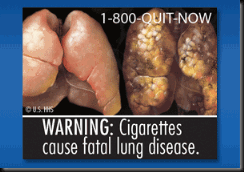Government scare tactics to stop smoking
 If you bought a fifth of Rum and found a picture on the bottle of a cirrhosis riddled liver, would it deter you from drinking? How about a picture of a blocked artery on the package of steak you buy at your local grocery store? Maybe a picture of a decapitated body would make you secure your seat belt?
If you bought a fifth of Rum and found a picture on the bottle of a cirrhosis riddled liver, would it deter you from drinking? How about a picture of a blocked artery on the package of steak you buy at your local grocery store? Maybe a picture of a decapitated body would make you secure your seat belt?
Since 1966, the US Food and Drug Administration (FDA) has mandated the placement of warnings on packs of cigarettes with messages such as:
- Caution: Cigarette Smoking May be Hazardous to Your Health.
- Warning: The Surgeon General Has Determined that Cigarette Smoking is Dangerous to Your Health
- SURGEON GENERAL’S WARNING: Smoking Causes Lung Cancer, Emphysema And May Complicate Pregnancy.
- SURGEON GENERAL’S WARNING: Quitting Smoking Now Greatly Reduces Serious Risks to Your Health.
- SURGEON GENERAL’S WARNING: Smoking By Pregnant Women May Result in Fetal Injury, And Low Birth Weight.
- SURGEON GENERAL’S WARNING: Cigarette Smoke Contains Carbon Monoxide.
Yet with all the warnings, a significant percent of the public still smokes. A study performed by Dr. Lynn T. Koslowski, an addiction expert at Pennsylvania State University, demonstrated that Nicotine was nearly three times more addictive than Cocaine and twice that of Heroine. On a dependency scale, with one being the most difficult to quit and six being the easiest, Nicotine was the only substance to achieve a score of one.
While the number of smokers in the U.S. has dropped significantly in the four decades since the FDA mandated labeling, the number of new smokers versus quitting smokers has remained relatively stagnant for the past 15 years. Could it be that the U.S. government’s attempts to address smoking through warning messages aren’t the primary reason for the decline in smoking? Could there be other factors, such as a greater focus on healthful lifestyles, fitness and economics?
In 1966, when the FDA began requiring labeling on cigarette packs, the cost of a pack of cigarettes averaged 50 center while in 2011 it’s approaching $5.00, a ten-fold increase. For a pack-a-day smoker that’s nearly $2,000 per year. At least 30 percent of the increase in the cost of cigarettes can be attributed to federal and state excise taxes.
Public health officials love cigarette tax increases because many studies show that this leads to a decrease in smoking rates. This is especially prevalent among teenagers. For every ten percent increase in the price of a pack of cigarettes, youth smoking rates overall drop about seven percent. This rate is also true for minorities and low-income smokers, making tobacco taxes the most regressive of all taxes. When Wisconsin raised its state cigarette tax to $1.00 per pack, the hot-line received a record of 20,000 calls in a two month time period versus its typical 9,000 calls annually.
But despite the “taxes to engineer behavior” approach of state and federal governments, overall anti-tobacco sentiment is the single biggest reason for a decrease in smoking rates. The banning of smoking in public places, specifically office buildings and restaurants has made smoking either impractical or very difficult for employees in many businesses. It’s tantamount to forcing all your employees to eat at the company snack bar and only serving carrots and celery. Your employees will almost certainly lose weight, but they probably wouldn’t be the most pleasant people to be around.
Nowhere is there a study that supports the government’s cigarette package labeling as being a deterrent to smoking. In 1966 there was still a debate about the health effects of smoking, so warnings on packs were considered a particular “point-of-view.” The tobacco companies denied (and many still do) that there is a direct relationship between smoking and a variety of smoking related illnesses. However in 2011 that debate is no longer an issue. The public is well aware of the deleterious effects of smoking, so the value of telling someone that smoking isn’t good for them is like telling them the sky is blue; but the FDA won’t let that deter them.
 Today the FDA unveiled grizzly images to replace the words on a pack of cigarettes. Instead of a few stern words from the surgeon general. The new packages will feature graphic pictures such as a guy blowing smoke through a tracheotomy hole in his neck, a corpse with an evidently unsuccessful surgical scar running down his chest, a cancerous lip and a set of diseased
Today the FDA unveiled grizzly images to replace the words on a pack of cigarettes. Instead of a few stern words from the surgeon general. The new packages will feature graphic pictures such as a guy blowing smoke through a tracheotomy hole in his neck, a corpse with an evidently unsuccessful surgical scar running down his chest, a cancerous lip and a set of diseased  lungs. There’s even one which features a cartoon of a distressed baby in an incubator along with the warning that “smoking during pregnancy can harm your baby.”
lungs. There’s even one which features a cartoon of a distressed baby in an incubator along with the warning that “smoking during pregnancy can harm your baby.”
The best anti-smoking campaign should be centered around preventing people from starting. When the average teenager is given a cigarette by a friend, the friend doesn’t hand them the pack to check the latest scary images; they hand them a  cigarette. Once hooked, there’s nothing in these images that are likely to make a dramatic change in the smoking habits of smokers.
cigarette. Once hooked, there’s nothing in these images that are likely to make a dramatic change in the smoking habits of smokers.
Polls have shown that nearly 8 in 10 smokers want to quit and would if they felt they could. They usually don’t undertake the demanding task of quitting because of the cost and stress. If the government wants to help smokers quit, rather than spending millions upon millions on messages, images and anti-smoking advertising, take that money and give tax credits on the cost of anti-smoking devices, drugs and the like. The cost of Nicotine gums and lozenges is nearly as expensive as smoking providing little incentive. The cost of FDA approved smoking cessation drugs, such as Zyban and Chantix can be much higher.
 Government has never been very successful at social engineering through scare tactics or monetary means, nor should they be. The goal should be to help those who wish to quit, instead of pushing them into a behavior the government would prefer. It matters not whether the goal is a worthy one, only that our government was never intended to herd us like cattle into the pen of healthier living. If we accept our government’s meddling in our vices, we’ve invited them to dictate all areas of our lives.
Government has never been very successful at social engineering through scare tactics or monetary means, nor should they be. The goal should be to help those who wish to quit, instead of pushing them into a behavior the government would prefer. It matters not whether the goal is a worthy one, only that our government was never intended to herd us like cattle into the pen of healthier living. If we accept our government’s meddling in our vices, we’ve invited them to dictate all areas of our lives.
[widgets_on_pages id=”Underpost”]
